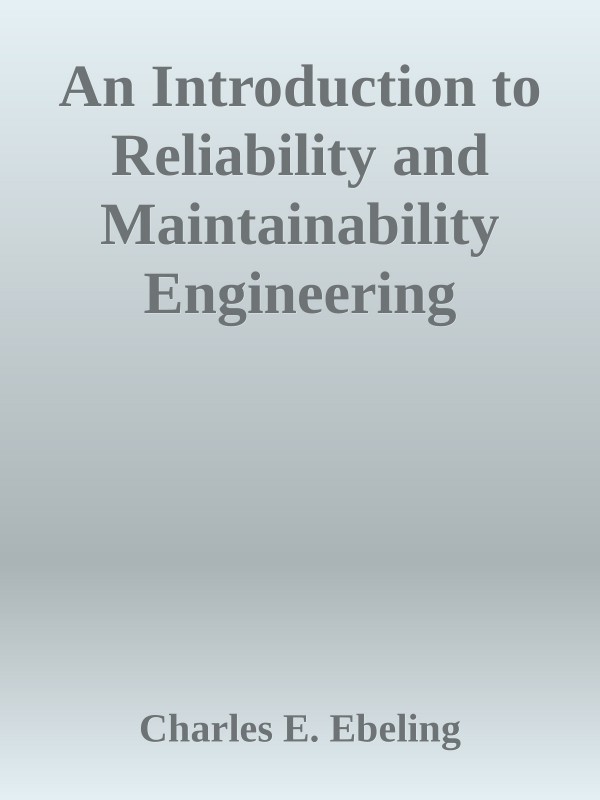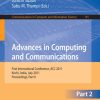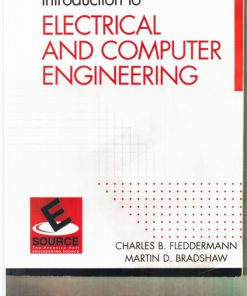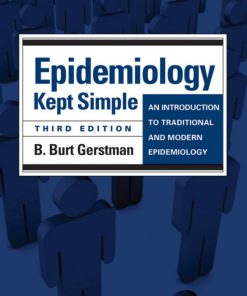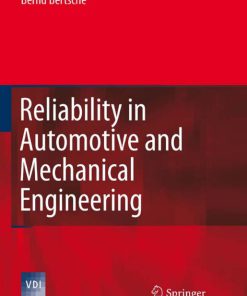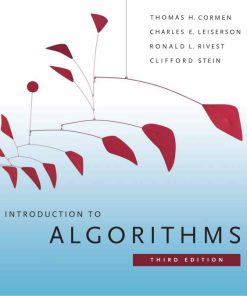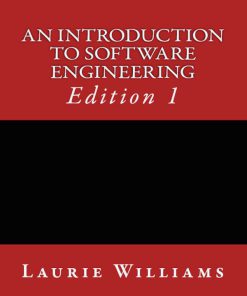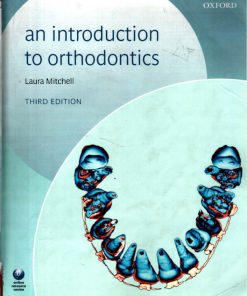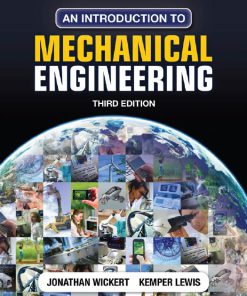An Introduction to Reliability and Maintainability Engineering 3rd Edition by Charles Ebeling ISBN 9781478639251 1478639253
$50.00 Original price was: $50.00.$25.00Current price is: $25.00.
Authors:Charles E. Ebeling , Series:IT & Computer [195] , Tags:Computer Communication Networks; Information Technology , Author sort:Ebeling, Charles E. , Ids:Google; 9780070421387 , Languages:Languages:eng , Published:Published:Mar 2004 , Publisher:Tata McGraw-Hill Education , Comments:Comments:”Many books on reliability focus on either modeling or statistical analysis and require an extensive background in probability and statistics. Continuing its tradition of excellence as an introductory text for those with limited formal education in the subject, this classroom-tested book introduces the necessary concepts in probability and statistics within the context of their application to reliability. The Third Edition adds brief dis …”
An Introduction to Reliability and Maintainability Engineering 3rd Edition by Charles Ebeling – Ebook PDF Instant Download/Delivery. 9781478639251 ,1478639253
Full download An Introduction to Reliability and Maintainability Engineering 3rd Edition after payment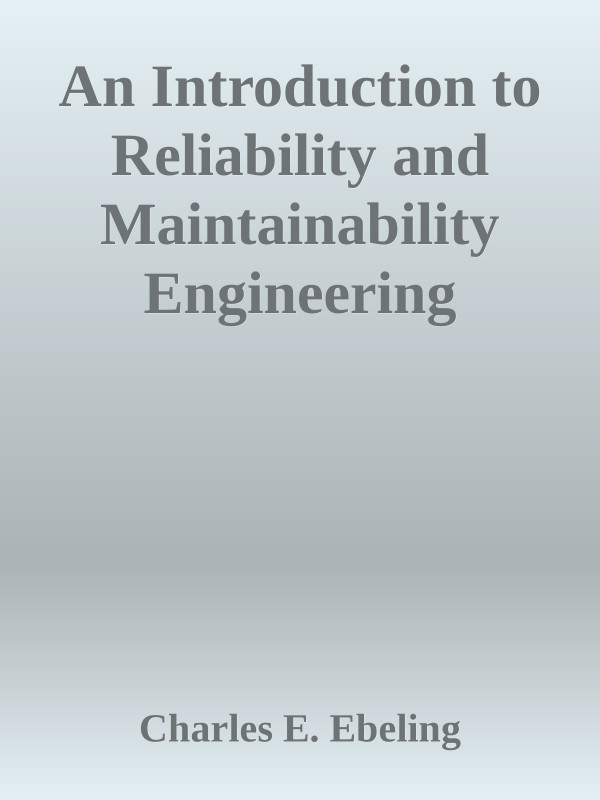
Product details:
ISBN 10: 1478639253
ISBN 13: 9781478639251
Author: Charles Ebeling
An Introduction to Reliability and Maintainability Engineering 3rd Edition Table of contents:
CHAPTER 1: Introduction
1.1 THE STUDY OF RELIABILITY AND MAINTAINABILITY
1.1.1 Reliability Improvement
1.1.2 Random versus Deterministic Failure Phenomena
1.2 CONCEPTS, TERMS, AND DEFINITIONS
1.3 APPLICATIONS
1.4 A BRIEF HISTORY
1.5 RELIABILITY ENGINEERING AS A PROFESSION
Appendix 1A
Appendix 1B
Exercises
PART I: Basic Reliability Models
CHAPTER 2: The Failure Distribution
2.1 THE RELIABILITY FUNCTION
2.2 MEAN TIME TO FAILURE
2.3 HAZARD RATE FUNCTION
2.4 BATHTUB CURVE
2.5 CONDITIONAL RELIABILITY
2.6 SUMMARY
Appendix 2A
Appendix 2B
Appendix 2C
Appendix 2D
Appendix 2E
Exercises
Supplementary Exercises
CHAPTER 3: Constant Failure Rate Model
3.1 THE EXPONENTIAL RELIABILITY FUNCTION
3.2 FAILURE MODES
3.2.1 Failure Modes with CFR Model
3.2.2 Failures on Demand
3.3 APPLICATIONS
3.3.1 Renewal Process
3.3.2 Repetitive Loading
3.3.3 Reliability Bounds
3.4 THE TWO-PARAMETER EXPONENTIAL DISTRIBUTION
3.5 POISSON PROCESS
3.6 REDUNDANCY AND THE CFR MODEL
Exercises
Supplementary Exercises
CHAPTER 4: Time-Dependent Failure Rate Models
4.1 THE WEIBULL DISTRIBUTION
4.1.1 Design Life, Median, and Mode
4.1.2 Conditional Reliability
4.1.3 Failure Modes
4.1.4 Identical Weibull Components
4.1.5 The Three-Parameter Weibull
4.1.6 Redundancy with Weibull Failures
4.1.7 The Minimum Extreme Value Distribution
4.2 THE NORMAL DISTRIBUTION
4.3 THE LOGNORMAL DISTRIBUTION
4.4 THE GAMMA DISTRIBUTION
Appendix 4A
Appendix 4B
Appendix 4C
Appendix 4D
Appendix 4E
Appendix 4F
Exercises
Supplementary Exercises
CHAPTER 5: Reliability of Systems
5.1 SERIAL CONFIGURATION
5.2 PARALLEL CONFIGURATION
5.3 COMBINED SERIAL-PARALLEL SYSTEMS
5.3.1 High-Level versus Low-Level Redundancy
5.3.2 k-out-of-n Redundancy
5.3.3 Complex Configurations
5.4 SYSTEM STRUCTURE FUNCTION, MINIMAL CUTS, AND MINIMAL PATHS (OPTIONAL)
5.4.1 Coherent Systems
5.4.2 Minimal Path and Cut Sets
5.4.3 System Bounds
5.5 COMMON-MODE FAILURES
5.6 THREE-STATE DEVICES
5.6.1 Series Structure
5.6.2 Parallel Structure
5.6.3 Low-Level Redundancy
5.6.4 High-Level Redundancy
Exercises
Supplementary Exercises
CHAPTER 6: State-Dependent Systems
6.1 MARKOV ANALYSIS
6.2 LOAD-SHARING SYSTEM
6.3 STANDBY SYSTEMS
6.3.1 Identical Standby Units
6.3.2 Standby System with Switching Failures
6.3.3 Three-Component Standby System
6.4 DEGRADED SYSTEMS
6.5 THREE-STATE DEVICES
6.6 SIMULATING DEPENDENT SYSTEMS
Appendix 6A
Appendix 6B
Appendix 6C
Exercises
Supplementary Problems
CHAPTER 7: Physical Reliability Models
7.1 COVARIATE MODELS
7.1.1 Proportional Hazards Models
7.1.2 Location-Scale Models
7.2 STATIC MODELS
7.2.1 Random Stress and Constant Strength
7.2.2 Constant Stress and Random Strength
7.2.3 Random Stress and Random Strength
7.2.4 Mixed Distributions with Analytical Solutions
7.2.5 Simulating Stress and Strength Distributions
7.3 DYNAMIC MODELS
7.3.1 Periodic Loads
7.3.2 Random Loads
7.3.3 Random Fixed Stress and Strength
7.3.4 Simulated Time between Loads
7.4 PHYSICS-OF-FAILURE MODELS
Exercises
Supplementary Exercises
CHAPTER 8: Design for Reliability
8.1 RELIABILITY SPECIFICATION AND SYSTEM MEASUREMENTS
8.1.1 System Effectiveness
8.1.2 Economic Analysis and Life-Cycle Costs
8.2 RELIABILITY ALLOCATION
8.2.1 Exponential Case
8.2.2 Optimal Allocations
8.2.3 ARINC Method
8.2.4 AGREE Method
8.2.5 Redundancies
8.3 DESIGN METHODS
8.3.1 Parts and Material Selection
8.3.2 Derating
8.3.3 Stress-Strength Analysis
8.3.4 Complexity and Technology
8.3.5 Redundancy
8.4 FAILURE ANALYSIS
8.4.1 Product Definition
8.4.2 Identification of Failure Modes
8.4.3 Determination of Cause
8.4.4 Assessment of Effect
8.4.5 Estimation of Probability of Occurrence
8.4.6 Estimation of Detection
8.4.7 Classification of Severity
8.4.8 Computation of Criticality
8.4.9 Determination of Corrective Action
8.5 SYSTEM SAFETY AND FAULT TREE ANALYSIS
8.5.1 Fault Tree Analysis
8.5.2 Minimal Cut Sets
8.5.3 Quantitative Analysis
Exercises
Supplementary Exercises
CHAPTER 9: The Repair Process
9.1 ANALYSIS OF DOWNTIME
9.2 THE REPAIR-TIME DISTRIBUTION
9.2.1 Exponential Repair Times
9.2.2 Lognormal Repair Times
9.3 STOCHASTIC POINT PROCESSES
9.3.1 Renewal Process
9.3.2 Minimal Repair Process
9.3.3 Overhaul and Cycle Time
9.4 SYSTEM REPAIR TIME
9.5 RELIABILITY UNDER PREVENTIVE MAINTENANCE
9.6 STATE-DEPENDENT SYSTEMS WITH REPAIR
Appendix 9A
Appendix 9B
Appendix 9C
Appendix 9D
Appendix 9E
Exercises
Supplementary Exercises
CHAPTER 10: Design for Maintainability
10.1 MAINTENANCE REQUIREMENTS
10.1.1 Measurements and Specifications
10.1.2 Maintenance Concepts and Procedures
10.1.3 Component Reliability and Maintainability
10.2 DESIGN METHODS
10.2.1 Fault Isolation and Self-Diagnostics
10.2.2 Parts Standardization and Interchangeability
10.2.3 Modularization and Accessibility
10.2.4 Repair versus Replacement
10.2.5 Proactive Maintenance
10.3 HUMAN FACTORS AND ERGONOMICS
10.4 MAINTAINABILITY PREDICTION AND DEMONSTRATION
10.4.1 Maintainability Prediction
10.4.2 Maintainability Demonstration
Exercises
Supplementary Exercises
CHAPTER 11: Availability
11.1 CONCEPTS AND DEFINITIONS
11.1.1 Inherent Availability
11.1.2 Achieved Availability
11.1.3 Operational Availability
11.1.4 Generalized Operational Availability
11.1.5 Availability with Minimal Repair
11.2 EXPONENTIAL AVAILABILITY MODEL
11.3 SYSTEM AVAILABILITY
11.3.1 Availability with Standby Systems
11.3.2 Steady-State Availability
11.3.3 Matrix Approach
11.4 INSPECTION AND REPAIR AVAILABILITY MODEL
APPENDIX 11A
Exercises
Supplementary Exercises
PART II: The Analysis of Failure Data
CHAPTER 12: Data Collection and Empirical Methods
12.1 DATA COLLECTION
12.2 EMPIRICAL METHODS
12.2.1 Ungrouped Complete Data
12.2.2 Grouped Complete Data
12.2.3 Ungrouped Censored Data
12.2.4 Grouped Censored Data
12.3 STATIC LIFE ESTIMATION
12.4 NONPARAMETRIC CONFIDENCE INTERVALS
Exercises
CHAPTER 13: Identifying Failure and Repair Distributions
13.1 IDENTIFYING CANDIDATE DISTRIBUTIONS
13.2 PROBABILITY PLOTS AND LEAST-SQUARES CURVE-FITTING
13.2.1 Exponential Plots
13.2.2 Weibull Plots
13.2.3 Normal Plots
13.2.4 Lognormal Plots
13.2.5 Multiply Censored Time Plots
13.2.6 Curve Fitting for the Minimum Extreme-Value Distribution
13.3 PARAMETER ESTIMATION
13.3.1 Maximum Likelihood Estimator
13.3.2 Exponential MLE
13.3.3 Weibull MLE
13.3.4 Normal and Lognormal MLEs
13.3.5 Maximum Likelihood Estimation with Multiply Censored Data
13.3.6 Location Parameter Estimation
13.3.7 Parameter Estimation for the Minimum Extreme-Value Distribution
13.3.8 Parameter Estimation for the Gamma Distribution
13.3.9 Parameter Estimation for Interval Data
13.4 CONFIDENCE INTERVALS
13.4.1 Confidence Intervals for the Constant Failure Rate Model
13.4.2 Confidence Intervals for Other Distributions
13.5 PARAMETER ESTIMATION FOR COVARIATE MODELS
Appendix 13A
Appendix 13B
Appendix 13C
Appendix 13D
Exercises
Supplementary Exercises
CHAPTER 14: Statistical Tests
14.1 CHI-SQUARE GOODNESS-OF-FIT TEST
14.2 BARTLETT’S TEST FOR THE EXPONENTIAL DISTRIBUTION
14.3 MANN’S TEST FOR THE WEIBULL DISTRIBUTION
14.4 KOLMOGOROV-SMIRNOV TEST FOR NORMAL AND LOGNORMAL DISTRIBUTIONS
14.5 ANDERSON-DARLING TEST
14.6 ESTIMATION AND TESTS FOR THE NHPP
14.6.1 Parameter Estimation for the Power Law Process
14.6.2 Trend Test
14.6.3 Goodness-of-fit Test for Power Law
14.6.4 Grouped Data for Power Law Process
14.6.5 Parameter Estimation for the Log-Linear Process
14.7 ON FITTING DISTRIBUTIONS
Appendix 14A
Exercises
CHAPTER 15: Reliability Testing
15.1 PRODUCT TESTING
15.2 RELIABILITY LIFE TESTING
15.3 TEST TIME CALCULATIONS
15.3.1 Length of Test
15.4 BURN-IN TESTING
15.5 ACCEPTANCE TESTING
15.5.1 Binomial Acceptance Testing
15.5.2 Sequential Tests
15.6 ACCELERATED LIFE TESTING
15.6.1 Number of Units on Test
15.6.2 Time Compression
15.6.3 Constant-Stress Models
15.6.4 Other Acceleration Models
15.7 RELIABILITY GROWTH TESTING
15.7.1 Idealized Growth Curve
15.7.2 Duane Growth Model
15.7.3 AMSAA Model
15.7.4 Other Growth Models
Appendix 15A
Appendix 15B
Exercises
Growth Testing Exercises
Supplementary Exercises
PART III: Application
CHAPTER 16: Reliability Estimation and Application
16.1 CASE 1: REDUNDANCY
16.2 CASE 2: BURN-IN TESTING
16.3 CASE 3: PREVENTIVE MAINTENANCE ANALYSIS
16.4 CASE 4: RELIABILITY ALLOCATION
16.5 CASE 5: RELIABILITY GROWTH TESTING
16.6 CASE 6: REPAIRABLE SYSTEM ANALYSIS
16.7 CASE 7: MULTIPLY CENSORED DATA
16.8 CASE 8: MULTIPLE FAILURE MODES
16.9 CASE 9: AVAILABILITY (Renewal Process)
16.10 Case 10: AVAILABILITY (Minimal Repair Process)
Exercises (Mini-Cases)
CHAPTER 17: Implementation
17.1 OBJECTIVES, FUNCTIONS, AND PROCESSES
17.2 THE ECONOMICS OF RELIABILITY AND MAINTAINABILITY AND SYSTEM DESIGN
17.2.1 Life-Cycle Cost Model
17.2.2 Minimal Repair
17.3 ORGANIZATIONAL CONSIDERATIONS
17.4 DATA SOURCES AND DATA COLLECTION METHODS
17.4.1 Field Data
17.4.2 Process Reliability and Operational Failures
17.4.3 External Data Sources
17.5 PRODUCT LIABILITY, WARRANTIES, AND RELATED MATTERS
17.6 SOFTWARE RELIABILITY
Appendix 17A
References
Partial Answers To Selected Exercises
CHAPTER 1
CHAPTER 2
CHAPTER 3
CHAPTER 4
CHAPTER 5
CHAPTER 6
CHAPTER 7
CHAPTER 8
CHAPTER 9
CHAPTER 10
CHAPTER 11
CHAPTER 12
CHAPTER 13
CHAPTER 14
CHAPTER 15
CHAPTER 16
Appendix: Statistical and Numerical Tables
Table A.1
table a.2
Table A.3
Table A.4
Table A.5
Table A.6
Table A.7
Table A.8
Table A.9
Table A.10
Index
People also search for An Introduction to Reliability and Maintainability Engineering 3rd Edition:
an introduction to reliability and maintainability engineering pdf
university of tennessee reliability and maintainability engineering
ebeling an introduction to reliability and maintainability engineering
solution manual an introduction to reliability and maintainability engineering
You may also like…
eBook PDF
An Introduction to Orthodontics 3rd Edition by Laura Mitchell ISBN 0198568126 9780198568124

